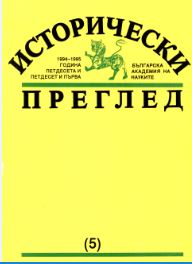Формирането на средновековната българска народност в светлината на някои наши апокрифи
The Formation of the Meidaeval Bulgarian Nationality in the Light of Some of Our Apocrypha
Author(s): Strashimir DimitrovSubject(s): History, Ethnohistory, Political history, Special Historiographies:, 18th Century, The Ottoman Empire
Published by: Институт за исторически изследвания - Българска академия на науките
Summary/Abstract: The author does not accept the hypothesis that in the 9th and 10th c., the Proto-Bulgarians were assimilated into the Slav mass and lost their language by which the formation of a united Bulgarian nationality was completed. In his vies, the well-known narratives about the Prophet Isaiah and the Bulgarians, and about Cyril the Philosopher and the conversion of the Bulgarians to Christianity contain important refutations of this hypothesis. The narrative about the Prophet Isaiah and the Bulgarians is dated by the author to the last third of the 12th c., and not to the 11th c. It tells haw by Cod’s order the Prophet Isaiah separated part of the Cumans and brought them across the Danube, arranged a state for them and converted them to Christianity whereby they were named “Bulgars”. In other words, at the end of the 12th c. for the compiler of the “Chronicle” the Bulgarians were part of the Cumans and resembled the Cumans, i.e. they were Turkish-speaking and not Slavonic-speaking people. He had seen such Bulgarians and this showed that a mass of not Slavonicized Proto-Bulgarians did exist. In the 7th – 12th c., however, proceeded also the Bulgarianization of the Slavs who were incorporated in the boundaries of the Bulgarian State and in the dioceze of the Bulgarian Church. The “Narrative How Cyril the Philosopher converted the Bulgarians to Christianity”, also a monument of the late 12th c., tells the story how Cyril on divine suggestion went among the Bulgarians, converted them to Christianity and made for them 32 Bulgarian letters, i.e. gave them a script. For the author of this work, written in Slav-Bulgarian, Cyril is a Bulgarian, not a Slavonic first teacher, the script created by him is Bulgarian, not Slavonic, as the authors of the 9th – 10th c. from Clement of Ochrid on write. In other words, the anonymous Slavonic author already defines his language as Bulgarian and hence himself as a Bulgarian. Therefore, already both Proto-Bulgarians and Slavs of the Bulgarian ethnic territory carried a Bulgarian self-awareness and a common ethnonym – Bulgarians. This is an indication that a united Bulgarian nationality had been formed.
Journal: Исторически преглед
- Issue Year: 1995
- Issue No: 5
- Page Range: 134-165
- Page Count: 32
- Language: Bulgarian
- Content File-PDF

